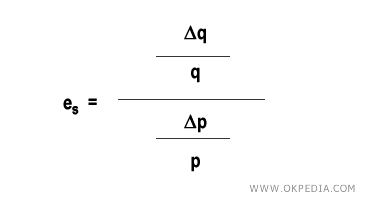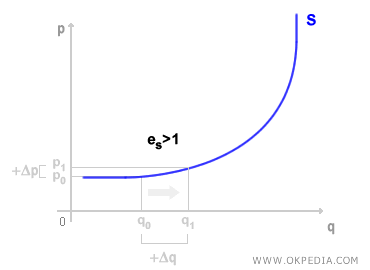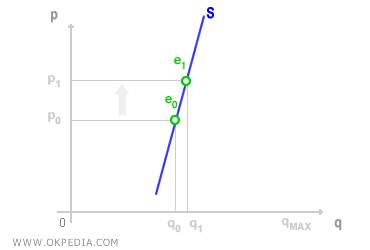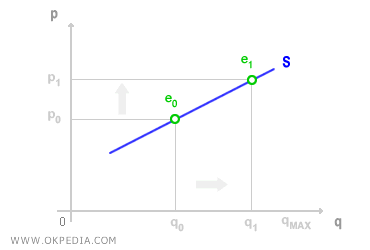Supply Elasticity
Supply elasticity refers to how responsive the supply of a good is to changes in its price. It is determined by the ratio of the percentage change in the quantity supplied (supply) to the percentage change in its price. This ratio is called the elasticity coefficient (es).

Elasticity is not constant; it varies with production levels. For example, in the early stages of a supply curve, elasticity is very high (the curve appears nearly horizontal). At this point, even a small change in price can lead to a disproportionately large increase in the quantity supplied. This section of the curve is described as elastic because the elasticity coefficient exceeds one (es>1). On a graph, an elastic supply curve is typically horizontal and almost parallel to the x-axis.

As production increases, the productivity of resources diminishes, and facilities approach their maximum capacity. Elasticity declines as production grows. The diagram below illustrates a case of unitary elasticity (es=1), where changes in production volume are directly proportional to changes in price.

In the later stages, the supply curve becomes inelastic. Here, the elasticity coefficient drops below one (es<1), meaning the quantity supplied increases at a less-than-proportional rate relative to price changes. Resource productivity declines rapidly, and production nears the maximum capacity of the facilities. The inelastic supply curve is typically steep, almost vertical, and closely aligned with the y-axis.

The process concludes at the end of the supply curve, where facilities reach full capacity, rendering the curve perfectly inelastic. At this point, elasticity equals zero (es=0). Any further increase in price has no effect on the quantity supplied, which remains constant (qmax). A rigid supply curve is completely vertical and parallel to the y-axis.


Short term. In the short term, the supply curve tends to be more rigid because businesses cannot immediately adjust production volumes due to production cycles and limited information. A time lag (t1) exists between a market price change and the moment entrepreneurs recognize it. Another time lag (t2) is required to increase production volumes (e.g., hiring additional workers) or to complete the ongoing production cycle. The longer the production cycle, the more inelastic the supply curve becomes in the short term.

Take agriculture as an example: production cycles are often lengthy. Even if market signals change (e.g., price drops), a farmer cannot adjust output mid-season while crops are already growing. They must wait for the harvest and the next planting season. Additionally, for perishable goods (e.g., fruits and vegetables), producers cannot stockpile inventory in hopes of better prices. They must sell their entire output, regardless of short-term price fluctuations. Therefore, in the short term, the supply curve is typically vertical. Over the medium term, however, it tends to become more elastic. It’s important to note that a rigid supply curve in the short term doesn’t necessarily indicate full capacity utilization. A producer might only be operating at 50% capacity but still be unable to increase production in the short term.
 Medium term. Over the medium term, the supply curve becomes more elastic. Businesses have enough time to respond to market signals, adjust production volumes, and adapt to price changes. During this period, production capacity remains fixed. However, a longer timeframe allows businesses to plan investments and expand their facilities. In the medium term, firms operate along the same short-term supply curve, but they can adjust output more effectively.
Medium term. Over the medium term, the supply curve becomes more elastic. Businesses have enough time to respond to market signals, adjust production volumes, and adapt to price changes. During this period, production capacity remains fixed. However, a longer timeframe allows businesses to plan investments and expand their facilities. In the medium term, firms operate along the same short-term supply curve, but they can adjust output more effectively.

 Long term. In the long term, businesses can expand their production capacity by building new facilities or adopting advanced technologies. Over this extended period, firms have sufficient time to plan investments and construct new production plants. Consequently, both elasticity and the position of the supply curve on the graph can change. For instance, increasing production capacity or opening additional facilities shifts the supply curve to the right.
Long term. In the long term, businesses can expand their production capacity by building new facilities or adopting advanced technologies. Over this extended period, firms have sufficient time to plan investments and construct new production plants. Consequently, both elasticity and the position of the supply curve on the graph can change. For instance, increasing production capacity or opening additional facilities shifts the supply curve to the right.

